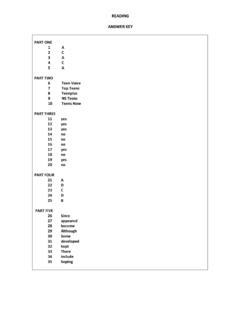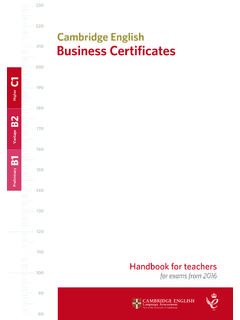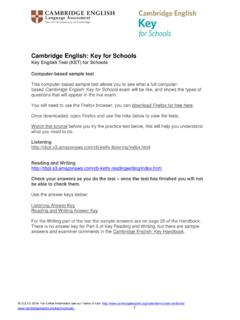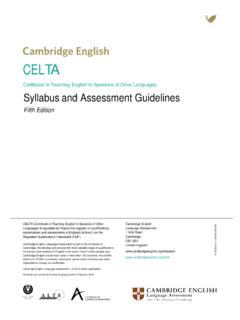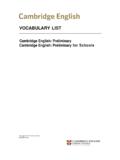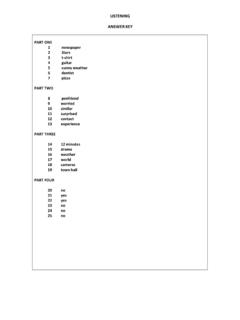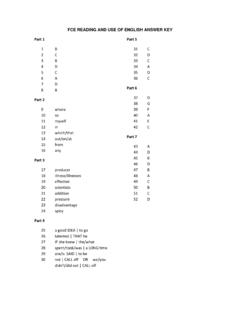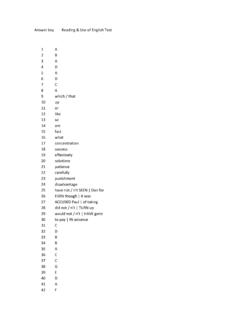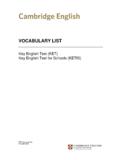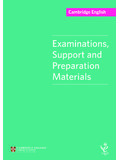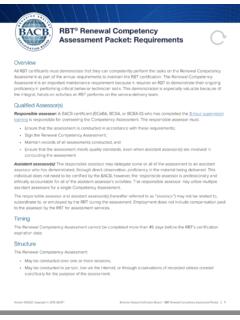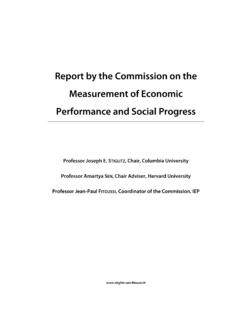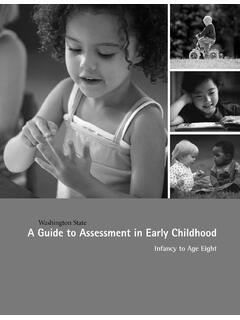Transcription of Examples of speaking performance at CEFR levels
1 1 Examples OF speaking performance AT cefr levels A2 TO C2 (Taken from Cambridge ESOL s Main Suite exams) Project overview April, 2009 University of Cambridge ESOL Examinations Research and Validation Group 2 3444567101315 Contents Contents ..2 Foreword .. Background to the Brief description of Cambridge ESOL s Main Suite speaking tests .. Procedure and Data Instruments .. Data Analysis .. References .. Appendix A: cefr assessment scales (Global and analytic).. Appendix B: example of a Rating 3 oreword This documentation accompanies the selected Examples of speaking tests at CEF levels A2 to C2. The selected speaking test performances were originally recorded for examiner training purposes, and are here collated for the use of the Council of Europe s Language Testing Division, Strasburg. The sample material is not collated to exemplify the exams on this occasion, but to provide speaking exemplars of CEF levels .
2 These speaking test selections are an additional resource (to the existing one on the Council s website) that Cambridge ESOL would like to share with other language testing and teaching professionals. The persons shown on these recordings have given their consent to the use of these recordings for research and training purposes only. Permission is given for the use of this material for examiner and teacher training in non-commercial contexts. No part of the selected recordings may be reproduced, stored, transmitted or sold without prior written permission. Written permission must also be sought for the use of this material in fee-paying training programmes. Further information on the content and exams exemplified in these sample tests is available in the Exam Handbooks, reports, and past papers, which can be obtained via the Cambridge ESOL website, or by contacting: University of Cambridge ESOL Examinations 1 Hills Road Cambridge CB1 2EU United Kingdom Tel.
3 +44 (0) 1223 553355 Fax. +44 (0) 1223 460278 e-mail: 4 n aking test performances at levels A2 to C2 of the CEF which could be he samples used were taken from Cambridge ESOL General English Examinations, henceforward s Main Suite speaking tests he Cambridge approach to speaking is grounded in communicative competence models, including unicative Language Ability (built on the work of Canale & Swain, 1980 and work of other researchers working in the field of task-based learning and Skehan, 2001; Weir, 1990, 2005). As Taylor (2003) notes in her discussion of the pproach to speaking assessment , Cambridge ESOL tests have always reflected a view of bility which involves multiple competencies ( , lexico-grammatical knowledge, rol, pragmatic awareness), to which has been added a more cognitive component hich sees speaking ability as involving both a knowledge and a processing factor. The knowledge ertoire of lexis and grammar which allow flexible, appropriate, precise he processing factor involves a set of procedures for blished phrasal chunks of language which enable the andidate to conceive, formulate and articulate relevant responses with on-line planning reduced to acceptable amounts and timings (Levelt, 1989).
4 In addition, spoken language production is seen as situated social practice which involves reciprocal interaction with others, as being purposeful and goal-oriented within a specific context. The features of the Cambridge ESOL speaking exams reflect the underlying construct of speaking . One of the main features is the use of direct tests of speaking , which aims to ensure that speech elicited by the test engages the same processes as speaking in the world beyond the test and reflects a view that speaking has not just a cognitive, but a socio-cognitive dimension. Pairing of candidates where possible is a further feature of Cambridge ESOL tests which allows for a more varied sample of interaction, candidate-candidate as well as candidate-examiner. Similarly, the use of a multi-part test format allows for different patterns of spoken interaction, question and answer, uninterrupted long turn, discussion. The inclusion of a variety of task and response types is supported by numerous researchers who have made the case that multiple-task tests allow for a wider range of language to be elicited and so provide more evidence of the underlying abilities tested, the construct, and contribute to the exam s fairness (Bygate, 1988; Chalhoub-Deville, 2001; Fulcher, 1996; Shohamy 2000; Skehan, 2001).
5 A further feature of the Cambridge ESOL speaking tests is the authenticity of test content and tasks, as well as authenticity of the candidate s interaction with that content (Bachman, 1990). A concern for authenticity in the Cambridge ESOL exams can be seen in the fact that particular attention is given IntroductioBackground to the project In line with the launch of an updated version of First Certificate of English (FCE) and Certificate in Advanced English (CAE) examinations in December 2008, Cambridge ESOL initiated a project with he aim to provide typical spetused as calibrated samples in CEF standardisation training and ultimately in aiding a common understanding of the CEF levels . Treferred to as Main Suite. Main Suite is five-level suite of examinations ranging from A2 to C2, namely, Key English Test (KET), Preliminary English Test (PET), FCE, CAE, and Certificate of Proficiency in English (CPE). ackground to Cambridge ESOL B TBachman s (1990) CommCanale, 1983) and theassessment (Cambridge aspeaking aphonological contwfactor relates to a wide repconstruction of utterances in real time.
6 Tpronunciation, lexico-grammar and estac 5 uring the design stage to using tasks which reflect real-world usage, the target language-use domain, and are relevant to the contexts and purposes for use of the candidates (Bachman, 1990; 5). eaking test format and task design, the underlying construct of spoken language ability also shapes the choice and definition of assessment criteria, which cover Grammar/Vocabulary, Discourse Management, Pronunciation, and Interactive Communication. The teria enables a focus on overall discourse performance as well as range, grammatical accuracy and phonological control. d a are targeted at greater flexibility in the language used at the level of the utterance, in interaction with other candidates or the examiner and in longer stretches of rocedure and Data collection Sample description s and eight raters. erline ple comprised four additional pairs of test takers (two at CAE/C1 dSaville, 2003; Spolsky, 199 As well as informing spuse of both analytical and global crion specific features such as lexical Task specifications at all levels of the speaking papers ( in terms of purpose, audience, length, known assessment criteria, etc) are intended to reflect increasing demands on the candidate in termsof Levelt s (1989) four stages of speech processing.)
7 Tasks at the higher levels are more abstract anspeculative than at lower levels and are intended to place greater demands on the candidates cognitive resources. Scoring criterispeech. P he project involved a marking exercise with 28 test takers distributed in 14 pairTThe test-taker samples came from a pool of existing Cambridge ESOL speaking test performances which are high-quality test recordings used in rater training. In selecting the test takers to be used in the marking exercise, a variety of nationalities was targeted, not just European, and both male and female test takers were included. The project consisted of two phases. Twenty test takers distributed in 10 pairs were used during phase 1. They were taken from an available pool of 25 speaking tests which are used for rater training purposes and are marked against a global and analytic Main Suite oral assessment scale. The selection of the 10 pairs was based on the Main Suite marks awarded, and typical performanceswere operationalised as performances at the 3 band range of the Main Suite scale, while borderline performances were located at the range of the scale.
8 Based on the typical/bordcriteria adopted, one typical pair and one borderline pair were selected per level, to further confirm raters ability to distinguish between borderline and typical candidates. Phase two of the project focused on performances at the C levels only where in phase 1 raters had a ow level of agreement and the samland two at CPE/C2). During this phase of the project a typical performance at CAE/C1 or CPE/C2 was operationalised as being at bands 4 of the Main Suite scale and a borderline performance was located at bands (See Findings for a more detailed discussion of the two project phases.) Entire speaking test performances, rather than test parts, were used in the sample in order to allow for longer stretches of candidate output to be used by the raters when rating. The use of whole tests alsoadded a time-dimension to the project, as full tests are more time consuming to watch and may introduce elements of fatigue.
9 The raters had to spend a minimum of 8 minutes and a maximum of 19 minutes per single viewing. Such practical considerations limited the number of performances at each phase of the project to two per level. 6 sts, as well as other Cambridge ESOL exams. They had also orm for vel of y d design was employed where all the raters marked all the test takers on all the ssessment criteria. The decision to select 8 raters was based on advise given by Cizek & Bunch 007: 242), and by the Council of Europe (2004). In addition, the number of observations recorded (8 ters giving 6 marks to 28 candidates) was in agreement with the sample size required by FACETS and allowed for measurements to be produced with a relatively small standard error of measurement. ) aking tests (20 candidates total); see d e not in the original CEF Raters Profile The eight raters participating in the project were chosen because of their extensive experience as aters for Main Suite speaking terparticipated in previous Cambridge ESOL marking trials and had been shown to be within the nharshness/leniency and consistency.
10 The raters had many years of experience as speaking examiners ranging from 11 to over 25 years, and were based in several parts of Europe. In addition,they had experience spanning different exams, with different task types and assessment scales, whichhad enriched their experience as raters. In terms of familiarity with the cefr , seven of the raters ndicted that they were familiar/very familiar with the cefr , while one rater reported a low-leifamiliarity with the cefr . As will be seen in the Instruments section, a cefr familiarisation activitgiven prior to the marking exercise was used to ensure that all raters had an adequate level of familiarity with the cefr . Design A fully-crossea(2raInstruments The raters were sent the following materials: Two scales from the CEF Manual: a global scale (COE, 2001: 24, referred to as Table in appendix A), and an analytic scale (COE, 2001: 28-29, referred to as Table in Appendix Acomprising five criteria: Range, Accuracy, Fluency, Interaction, Coherence (see Appendix A); A DVD with 10 Main Suite spe A CEF familiarisation task (see Appendix B); A rating form for recording the level awarded to each candidate and related comments (Appendix B); A feedback questionnaire.))
